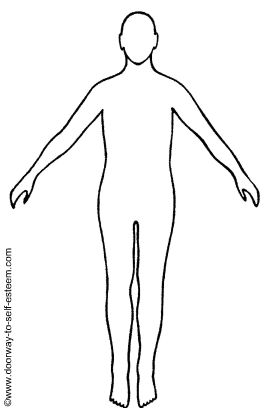Understanding Emotions:
Anger
by May Bleeker, 9 Aug 2010
Where do you feel it?
Understanding emotions is sometimes made easier by identifying the sensations they cause in the body.
Identifying what emotions feel like, locating them in the body, giving them a name and creating a metaphor for them (using colour or images) can help you understand not only what you are feeling, but how these feelings affect your behaviour.
Being able to recognize and understand your emotions is an important part of emotional intelligence. To better your emotional self awareness, try this practical exercise that explores the emotion of anger.
To do this exercise you need:
- A printed version of the human figure on this page
- A set of coloured pencils or felt-tip pens
When I Feel Angry...
Click on the image above to download a larger printable version (jpg 76KB).
1. Think about a recent situation in which you felt angry, or an old situation that still makes you angry. Picture the situation in your mind and try to remember what the feeling feels like in your body.
2. What does that emotion feel like? Choose a word, or fill in your own:
hot
cold
sharp
dull
heavy
burning
tight
3. Where are you feeling the emotion in your body? Is it in your head, your chest, your stomach, your arms, legs, feet, or hands? Do you feel it in front, or at the back? Up near the top, in your middle, or below?
4. Choose a colour or a set of colours that match your feeling.
Colour in the areas of the figure to show which parts of your body are affected by your feeling.
5. If you think about this feeling, do any images come to mind? Draw these small in the areas you feel they belong. Don't worry about being artistic, just draw something that reminds you of the image you see in your head.
e.g. If the image is of a dog worrying at a bone - draw the dog, or draw the bone!
6. Can you identify any other feelings that might be hanging around besides anger? What are they?
Write them down on the page.
What insights and thoughts come up in relation to these feelings? Do they remind you of anything? Can you see any connections between things? Do they remind you of anyone?
To wrap up the exercise simply take a deep breath and let go of all the insights, thoughts and ideas you may have had about your emotion of anger. Allow all the ideas, images, thoughts and feelings to subside and go back to wherever they came from. Hold on to nothing.
Note 1:
It is the process of doing this exercise that is useful, not necessarily the outcome. So don't worry too much about what your final picture looks like, or about any specifics. Whatever is useful will come up to be seen. Either during the exercise or afterwards. If nothing major comes to mind - no harm done!
By focusing your attention on your feelings you are practicing being self aware. This is the cornerstone of emotional intelligence.
However, giving emotions excessive attention can also be unhelpful! Strong feelings can perpetuate themselves, long after a situation has ended, particularly if we hang on to certain ideas about it.
After the exercise, be sure to let go of whatever ideas, thoughts and insights you have had about your emotions and focus on other things.
Note 2:
Emotional ups and downs are a normal part of everyday existence. If you have concerns about feeling excessive emotions, or emotions that seem inappropriately strong for the situation, please seek professional advice.
This exercise forms part of the Self Esteem in Action: Understanding Emotions Series.
Return from Understanding Emotions (Anger) to Self Esteem Activities
Return from Understanding Emotions (Anger) to Doorway to Self Esteem Home Page





New! Comments
Your feedback is welcome: